Are you feeling stuck with bland beige walls or tipical white interiors that lack personality? A black accent wall might be just what your living room needs. Once considered too bold or risky, black accent walls have emerged as a sophisticated design choice that can completely transform your space, creating depth, drama, and an unexpected sense of warmth.
In this comprehensive guide, we’ll explore twenty inspiring ways to incorporate a black accent wall into your living room—from minimalist approaches to luxurious statements. Whether you live in a sprawling suburban home or a cozy city apartment, these ideas will help you embrace the dramatic potential of black without overwhelming your space.
Why Choose a Black Accent Wall?
Before diving into specific design concepts, let’s address why black has become such a powerful choice for accent walls in recent years.
Black walls create an immediate sense of sophistication and drama that lighter colors simply cannot achieve. Interior designer Emma Johnson explains, “Black has an anchoring quality that grounds a space while simultaneously creating the illusion of receding walls—it’s this paradoxical effect that makes it so powerful in living rooms.”
Research published in the Journal of Environmental Psychology suggests that darker wall colors can actually create a sense of intimacy and coziness in larger spaces, contradicting the common belief that dark colors always make rooms feel smaller.
Some compelling reasons to consider a black accent wall:
- Creates instant visual impact without requiring extensive decoration
- Enhances other colors in the room, making them appear more vibrant
- Hides imperfections in wall surfaces better than lighter colors
- Works with virtually any design style from traditional to ultra-modern
- Makes artwork and decorative elements stand out dramatically
According to a 2023 survey by Sherwin-Williams, black accent walls were among the top five design choices for homeowners looking to refresh their living spaces without a complete renovation, with 68% reporting high satisfaction with the results.
Getting Started: Practical Considerations
Before grabbing a paint roller, there are some important factors to consider:
Assessing Your Light
A common misconception is that black walls require abundant natural light. While light certainly helps balance darkness, what’s more important is the quality and direction of light rather than simply the amount. South-facing rooms with consistent light throughout the day often work best, but east and west-facing rooms can create interesting effects as light changes.
“I always recommend studying your room at diffrent times of day before committing to black,” advises interior designer Marcus Chen. “Take photos morning, noon, and evening to understand how the light moves through your space.”
Choosing the Right Wall
Not all walls are created equal when it comes to accent treatment. Ideal candidates include:
- Walls with architectural features worth highlighting
- The wall behind your main seating arrangement
- Fireplace walls
- Media walls where TVs are mounted
- Shorter walls in rectangular rooms to improve proportions
The wall facing you as you enter the room is often the natural focal point, making it an excellent candidate for accent treatment.
Paint vs. Alternatives
While matte black paint is the most common approach, consider these alternatives:
- Black shiplap or wood paneling for texture and dimension
- Chalkboard paint for a functional twist
- Black wallpaper with subtle patterns or texture
- Black stone or tile for a luxurious, reflective surface
Now, let’s explore our twenty inspired design concepts:
Design Concept 1: High-Contrast Minimalism
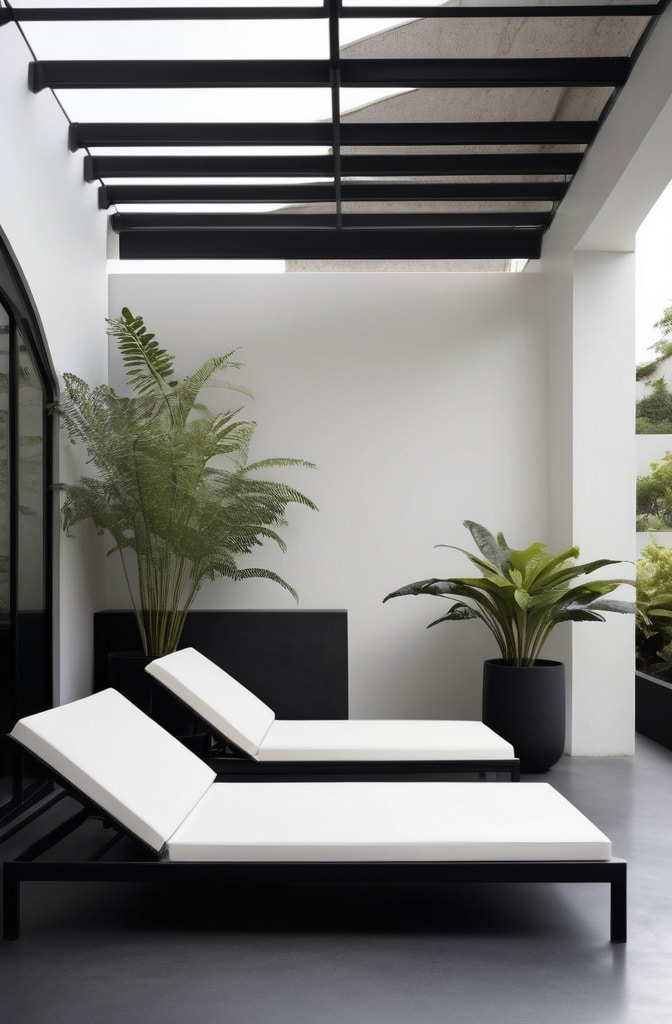
The striking juxtaposition of a deep black wall against crisp white furnishings creates a photographer’s dream—a living space with gallery-like precision and clarity.
This approach works best when you embrace true opposites: matte black walls paired with bright white seating, tables, and accessories. The contrast creates a sense of precision and intentionality that defines minimalist design.
To succeed with this look:
- Limit your palette strictly to black, white, and perhaps one additional neutral
- Focus on clean lines and uncluttered surfaces
- Choose furniture with simple silhouettes
- Incorporate plenty of negative space
- Add texture through materials rather than patterns
Designer tip: A single item in a natural material—like a wooden coffee table or woven basket—can prevent this high-contrast look from feeling too stark or clinical.
Design Concept 2: Luxe Metallics with Black

Black and metallic finishes have a natural affinity, creating a sense of luxury that feels both timeless and contemporary. Gold, brass, copper, and chrome all shine more brilliantly against black backgrounds.
“Black absorbs light while metals reflect it—this fundamental contrast is what makes the combination so effective,” explains metallurgist and design consultant Dr. Priya Sharma.
For a cohesive look:
- Choose one predominant metal tone and use it consistently
- Place metallic elements at different heights to create visual rhythm
- Consider both matte and polished versions of your chosen metal
- Incorporate metals in lighting fixtures, frames, hardware, and decorative objects
- Use metallic-threaded textiles for subtle continuity
Budget-friendly option: Spray paint thrift store frames and accessories in your chosen metallic finish for an affordable yet high-impact transformation.
Design Concept 3: Moody Mid-Century
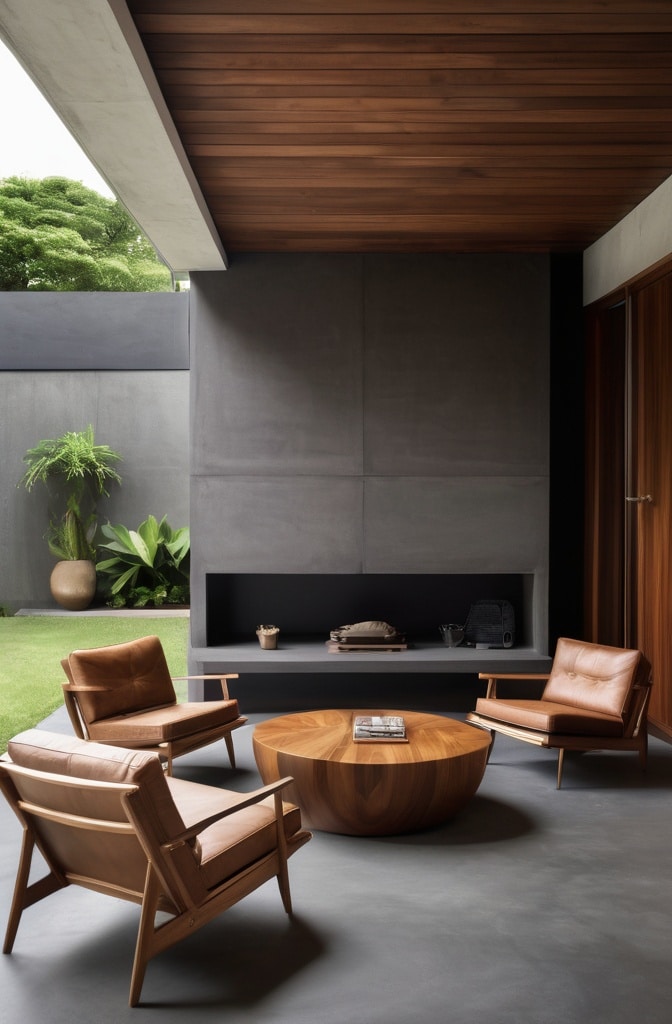
Mid-century modern furniture with its clean lines and organic curves stands out beautifully against black walls. The darkness acsentuates the distinctive silhouettes that define this popular style.
This approach works particularly well with walnut and teak furniture pieces, where the warmth of the wood creates a beautiful balance with the coolness of black walls.
To achieve this look:
- Focus on furniture with tapered legs and distinctive profiles
- Incorporate classic mid-century patterns like geometric prints and abstract forms
- Choose a warm-toned black like Sherwin-Williams “Tricorn Black” to complement wood tones
- Add authentic or reproduction mid-century lighting fixtures
- Consider a vintage bar cart as a functional accent piece
A 2023 report from Architectural Digest noted that mid-century modern remains the most enduring furniture style across generations, with 72% of designers incorporating elements of it into contemporary spaces.
Read This Blog:https://hometranquil.com/bedroom-wall-decoration-ideas/
Design Concept 4: Natural Wood Elements

The organic warmth of wood creates a captivating contrast against the cool sophistication of black walls. This pairing feels both grounded and elevated simultaneously.
Interior architect Sofia Martinez notes, “Wood against black creates a visual conversation between natural and bold, soft and strong. It’s this tension that makes spaces feel thoughtfully designed rather than simply decorated.”
Consider incorporating wood through:
- Floating shelves that appear to hover against the black background
- A substantial wooden coffee table or console
- Exposed ceiling beams if your architecture allows
- Wood-framed furniture pieces
- Wooden wall art or sculptures
Pro tip: When selecting wood tones, mid-range finishes like walnut and oak typically work better than very light options like pine or very dark varieties like ebony, which might disappear against the black.
Design Concept 5: Dramatic TV Feature Wall

A black wall behind your television creates a cinematic experience while elegantly disguising the technology. When the screen is off, it blends with the wall; when on, your viewing experience is enhanced by reduced visual distraction.
According to home theater specialist Jackson Lee, “A black wall behind the TV improves perceived contrast by up to 30% while reducing eye strain during extended viewing sessions.”
To perfect this approach:
- Consider running slim LED lighting behind the TV for a floating effect
- Install a wall-mounted media console in a contrasting material
- Hide cables within the wall during installation or use cord covers painted to match the wall
- Position ambient lighting to prevent glare on the screen
- Use acoustic panels in black fabric for improved sound quality in dedicated media rooms
This solution is particularly effective in open-concept spaces where you want to minimize the visual impact of technology.
Design Concept 6: Contemporary Cozy

Contrary to popular belief, black walls can create incredibly inviting, cozy spaces when balanced with the right elements. The key is layering soft textures and warm materials to create depth and tactile comfort.
To acheve this welcoming look:
- Incorporate plush textiles like velvet, bouclé, and chunky knits
- Layer multiple light sources at different heights
- Choose furniture with rounded rather than angular forms
- Add natural elements like plants, wood, and natural fibers
- Select a black with warm undertones like Benjamin Moore’s “Black Beauty”
Designer Ashley Chen, known for her “warm minimalist” approach, suggests, “Think of your black wall as the night sky—it’s dramatic, yes, but also the ultimate backdrop for warmth and intimate conversation.”
A study by the Color Association of the United States found that rooms with dark walls and layered lighting scored 27% higher on “perceived comfort” ratings than similarly furnished spaces with light walls.
Design Concept 7: Artistic Gallery Display
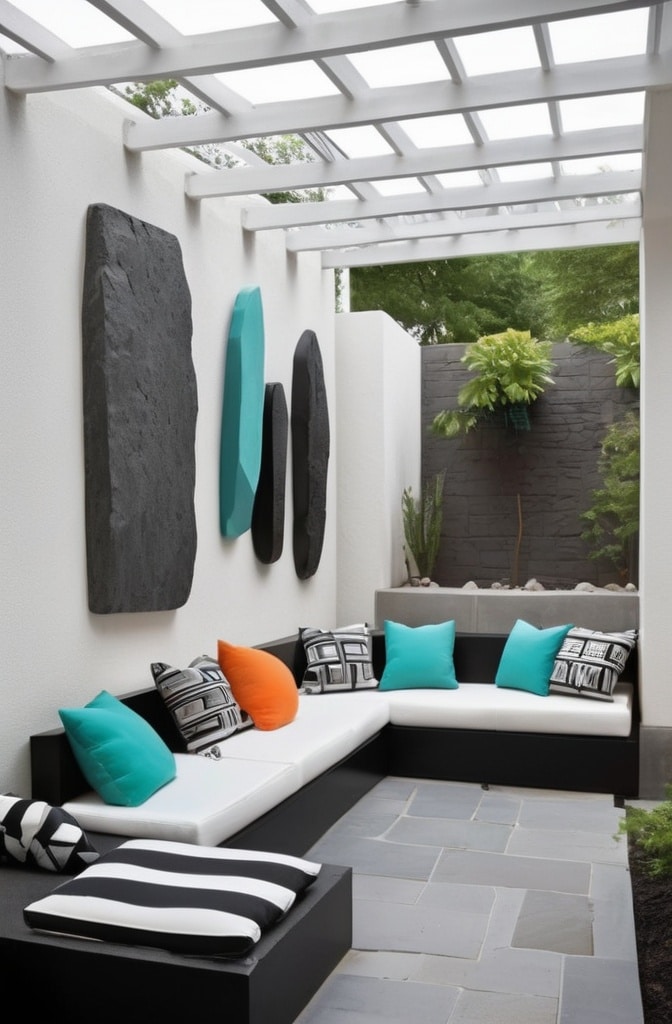
Black walls create the ultimate canvas for displaying art, functioning much like gallery walls in museums and high-end exhibitions. Colors appear more vibrant, whites look crisper, and the artwork becomes the undisputed focal point.
For an effective gallery wall:
- Mix media types for visual interest (paintings, photographs, textiles)
- Consider frames in contrasting materials—metallic frames pop dramatically
- Install proper lighting with adjustable gallery fixtures
- Arrange pieces with intentional spacing to let each work “breathe”
- Include three-dimensional objects like small sculptures or wall-mounted artifacts
“When creating a gallery display against black, think curatorialy rather than decoratively,” advises art consultant Maya Davis. “Each piece should earn its place and contribute to the overall narrative.”
Design Concept 8: Botanical Contrast

Plants against a black backdrop create stunning visual drama, with each leaf and branch seeming to float in space. This high-contrast pairing highlights the intricate structures and varied greens of houseplants.
Best plant varieties for black walls include:
- Monstera deliciosa – large, architectural leaves create dramatic shadows
- Fiddle leaf fig – vertical growth pattern creates height
- Pothos varieties – trailing vines can be trained to create living art
- Snake plants – structural form and yellow edges pop against black
- Bird of paradise – large paddle-shaped leaves create a sculptural effect
“Black walls make plant parenthood even more rewarding visually,” notes botanist and interior stylist Dr. Eliza Wong. “The contrast makes you notice details in your plants you might otherwise miss.”
Consider using wall-mounted planters or tall plant stands to create varying heights, and cluster plants in odd-numbered groupings for the most natural appearance.
Design Concept 9: Fireplace Focal Point
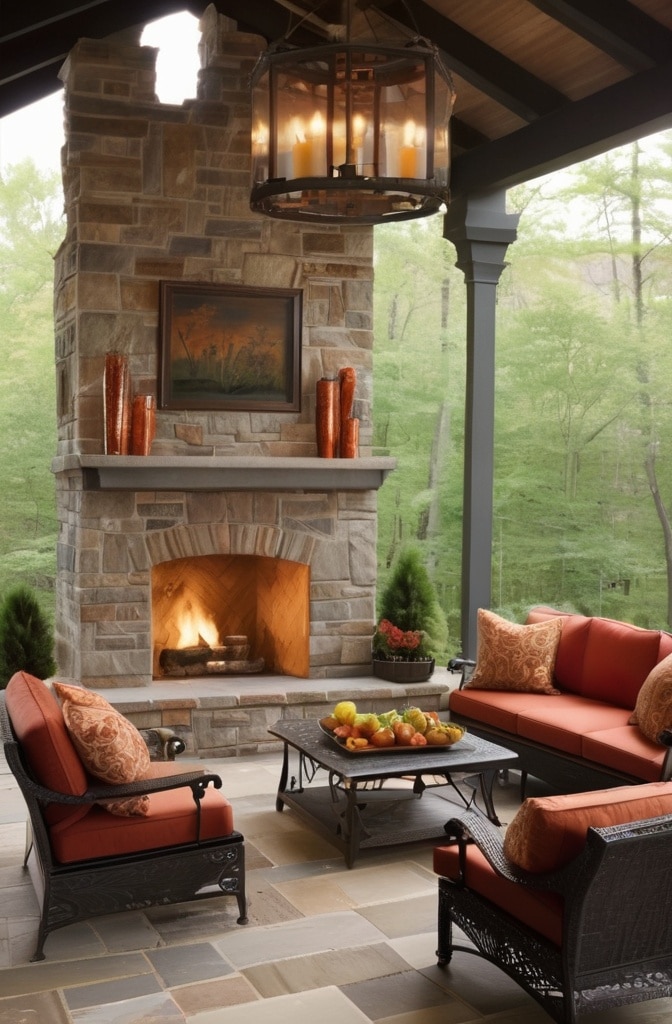
A black accent wall transforms an ordinary fireplace into a dramatic architectural feature, especially when the fireplace surround is in a contrasting material like marble, concrete, or light brick.
To maximize impact:
- Extend the black treatment to built-in shelving flanking the fireplace
- Choose a fireplace surround in a light material for maximum contrast
- Consider painting the mantel in a high-gloss black if it’s wooden
- Add metallic accessories that will reflect the firelight
- Incorporate large-scale art above the mantel as a secondary focal point
For gas or non-working fireplaces, cluster pillar candles of varying heights inside the firebox to create a warm glow that stands out beautifully against the black backdrop.
Design Concept 10: Geometric Statements
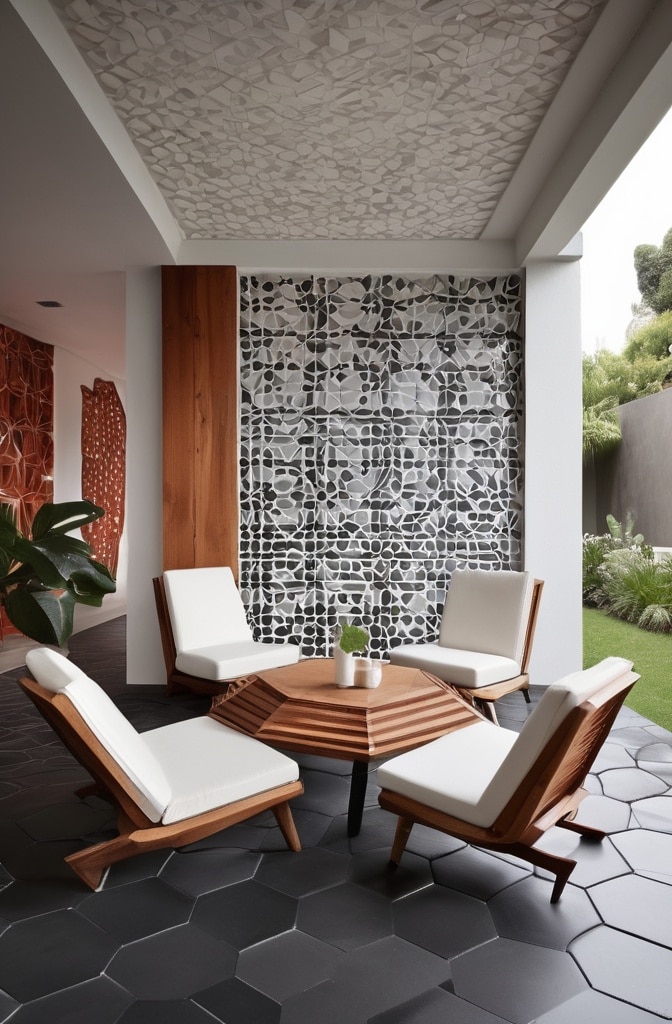
Geometric patterns against black create a sophisticated, architecturally interesting feature that goes beyond simple color contrast. Whether painted, wallpapered, or created with wood or metal overlays, geometric black walls add dimension and movement.
Popular approaches include:
- Herringbone or chevron patterns using matte and gloss black paints
- Gold or silver metallic tape creating Art Deco-inspired patterns
- Black textured wallpaper with subtle geometric elements
- 3D wall panels painted black for depth and shadow play
- Wooden slat feature walls with black backing
“Scale is crucial with geometric black walls,” advises architect Devon Parker. “In smaller rooms, keep patterns larger and simpler; more intricate designs work in larger spaces where you can appreciate them from a distance.”
Design Concept 11: Textured Black Surfaces
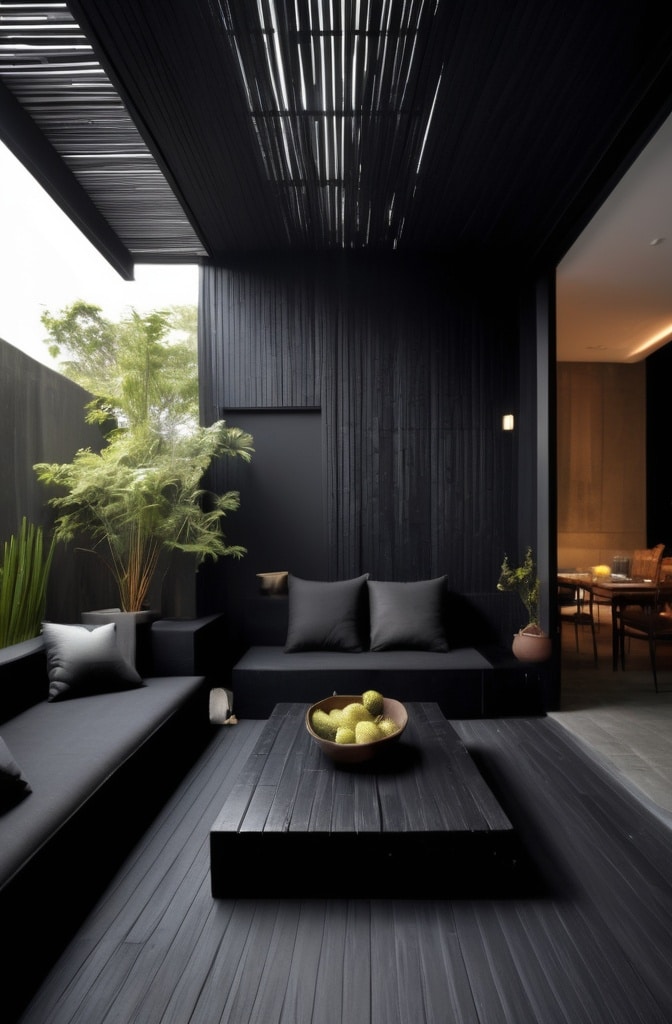
Moving beyond flat paint, textured black surfaces add depth, movement, and tactile interest to your accent wall. These treatments catch light differently throughout the day, creating subtle variation in what might otherwise be a flat expanse.
Compelling texture options include:
- Venetian plaster – creates a subtle sheen and dimensional quality
- Limewash – offers chalky, nuanced color variation
- Suede or velvet finish paints – provide a soft, light-absorbing surface
- Grasscloth wallcovering – adds natural texture and subtle pattern
- Tadelakt – waterproof Moroccan plaster with subtle sheen
“Texture transforms black from a simple color choice to a multisensory experience,” explains surface treatment specialist Ricardo Mendez. “It invites both visual and tactile engagement with the space.”
When using texture on black walls, simplify adjacent surfaces to prevent the room from feeling busy or overwhelming.
Design Concept 12: Industrial Edge

Black walls provide the perfect foundation for industrial design elements, enhancing the raw, utilitarian aesthetic that defines this popular style. The darkness amplifies the character of weathered materials and mechanical elements.
To achieve an authentic industrial look:
- Pair black walls with exposed brick, concrete, or reclaimed wood
- Incorporate metal furnishings with visible hardware
- Choose lighting with mechanical elements like pulleys or exposed bulbs
- Display vintage industrial objects as decorative elements
- Consider open shelving in raw materials rather than conventional cabinetry
“Industrial spaces are about honesty—exposed structures, visible function, authentic materials,” says former warehouse developer turned designer James Rodriguez. “A black wall creates the perfect backdrop for these elements to tell their story.”
Design Concept 13: Black + Books
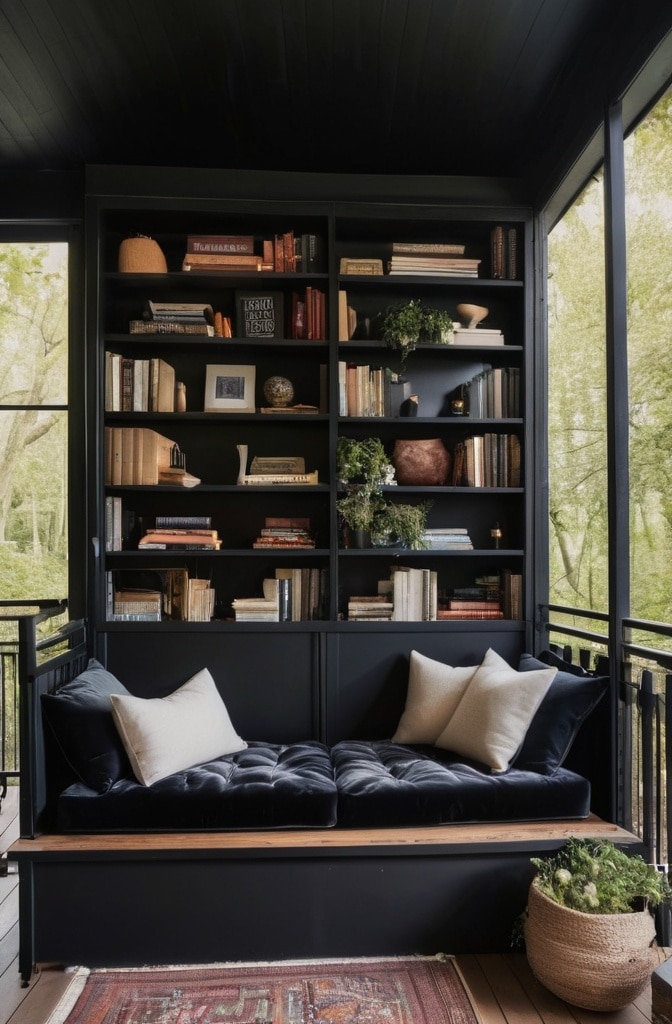
Bookshelves against a black wall create a distinctive library feel that highlights both the colored spines of books and the negative space around them. This approach works whether you have built-in shelving or freestanding units placed against the wall.
To maximize the effect:
- Arrange books by color for a rainbow effect against the black
- Incorporate bookends in contrasting materials like marble or brass
- Install subtle LED shelf lighting to illuminate book spines
- Leave some negative space for displaying objects among the books
- Consider painting the back of bookshelves black while keeping shelves themselves in a contrasting finish
Librarian and design consultant Andrea Thornfield notes, “Against black, books become more than just reading material—they transform into a cohesive design element that adds color, texture, and personality.”
Design Concept 14: Black and Light Flooring
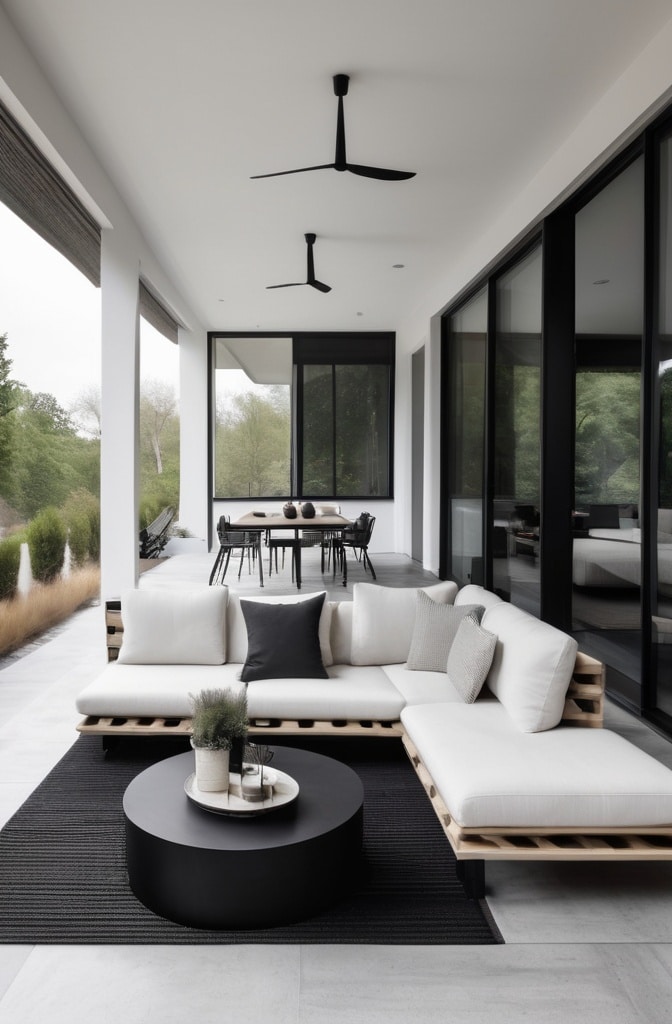
The combination of a black accent wall with light flooring creates a balanced, grounded space with dramatic vertical contrast. This pairing prevents the darkness from feeling heavy or overwhelming.
Successful flooring pairings include:
- Bleached oak or ash hardwood
- White-washed wide-plank pine
- Light limestone or concrete
- Pale terrazzo
- Cream or light gray carpet
“The eye naturally travels between the boldest contrasts in a room,” explains vision scientist and design consultant Dr. Marco Lee. “With black walls and light floors, you create a visual pathway that makes spaces feel larger and more dynamic.”
To bridge the contrast between dark walls and light floors, incorporate elements that feature both colors, such as black and white photography or patterned textiles with both dark and light elements.
Design Concept 15: Night Sky Inspiration
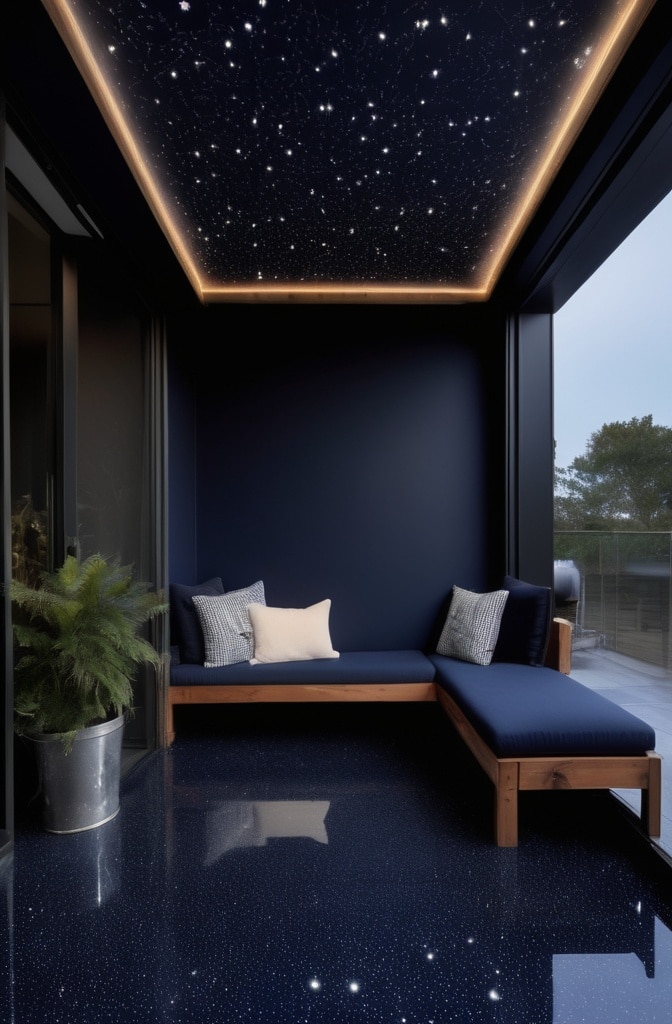
Transform your black accent wall into a sophisticated cosmic display by incorporating subtle celestial elements. This concept elevates black beyond just a color choice to create an immersive thematic experience.
Approaches range from subtle to statement:
- Tiny pinpoint fiber optic lights embedded in the wall for a starfield effect
- Constellation patterns created with metallic paint or small mirrors
- Moon phase wall hangings in metallic finishes
- Abstract art featuring cosmic imagery
- Specialized projectors that cast moving starlight effects
“The night sky has transfixed humans throughout history—bringing that sense of wonder indoors creates spaces that feel both timeless and contemplative,” notes astronomical designer Sarah Johnson.
This concept works particularly well in living rooms used for evening entertainment or relaxation, creating a naturally cozy atmosphere as daylight fades.
Design Concept 16: Smart Home Integration
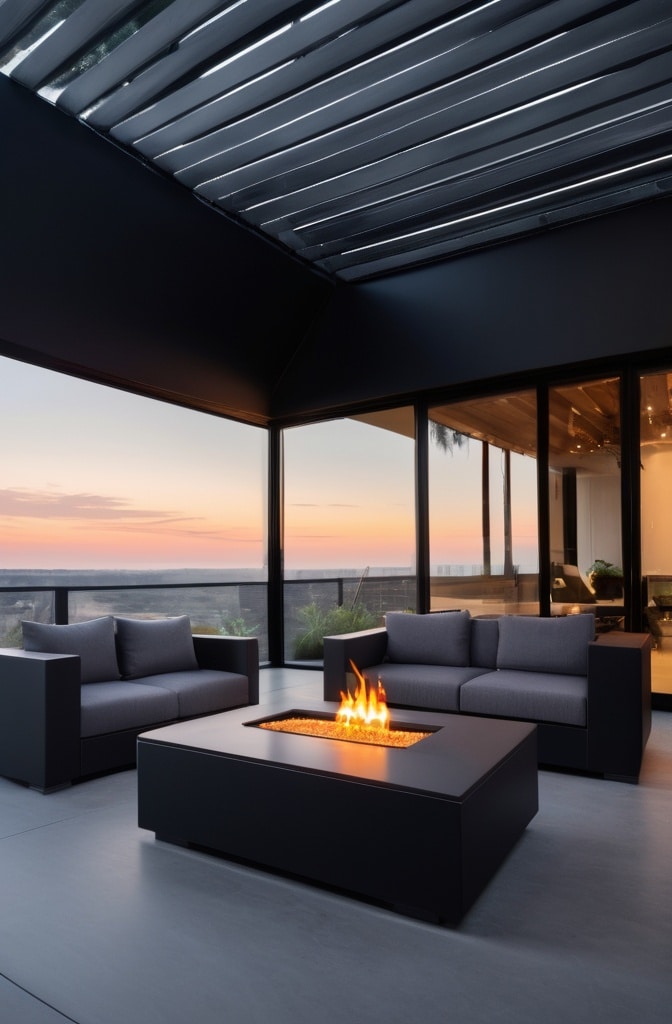
A black accent wall provides the perfect opportunity to seamlessly integrate smart home technology, as dark surfaces naturally camouflage screens, speakers, and control panels when not in use.
Consider these high-tech options:
- Black-bezeled smart displays that blend with the wall
- Integrated ambient lighting systems around the perimeter
- Hidden projection screens that descend from ceiling recesses
- Flush-mounted speakers with black grilles
- Touch-sensitive control panels with interfaces that disappear when inactive
According to smart home integrator Michael Chen, “Black walls are increasingly popular with our clients specifically because they minimize the visual footprint of technology while maximizing the experiential impact.”
This approach works especially well for multifunctional living rooms that transition between family time, entertaining, and media consumption.
Design Concept 17: Small Space Solutions
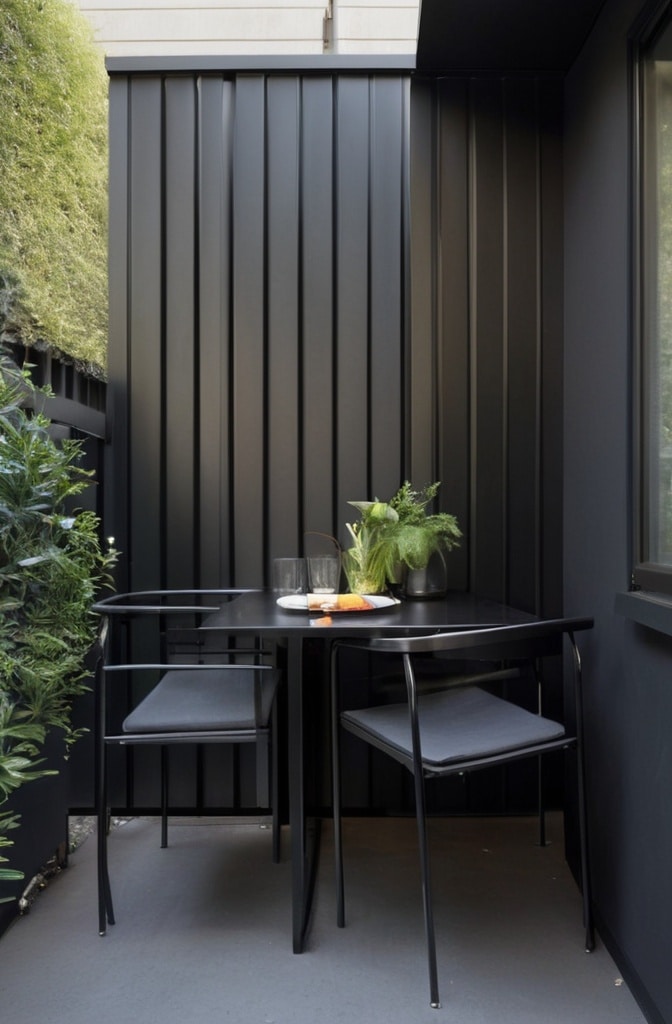
Contrary to conventional wisdom, black accent walls can actually make small living rooms feel more expansive by creating the illusion of depth and blurring perceptual boundaries.
To maximize this effect:
- Choose the wall furthest from the entry point for black treatment
- Keep furniture profiles low and lean
- Install mirrors on adjacent walls to reflect light
- Use leggy furniture that shows floor space underneath
- Keep window treatments minimal and in lighter tones
“In small spaces, a black accent wall functions almost like a theatrical scrim,” explains spatial psychologist Dr. Nina Thompson. “It creates the impression that the room continues beyond its actual dimensions.”
A 2022 study of urban apartments found that strategic use of very dark colors increased perceived spatial satisfaction by 23% compared to all-white treatments of the same spaces.
Design Concept 18: Black + Bold Color Accents
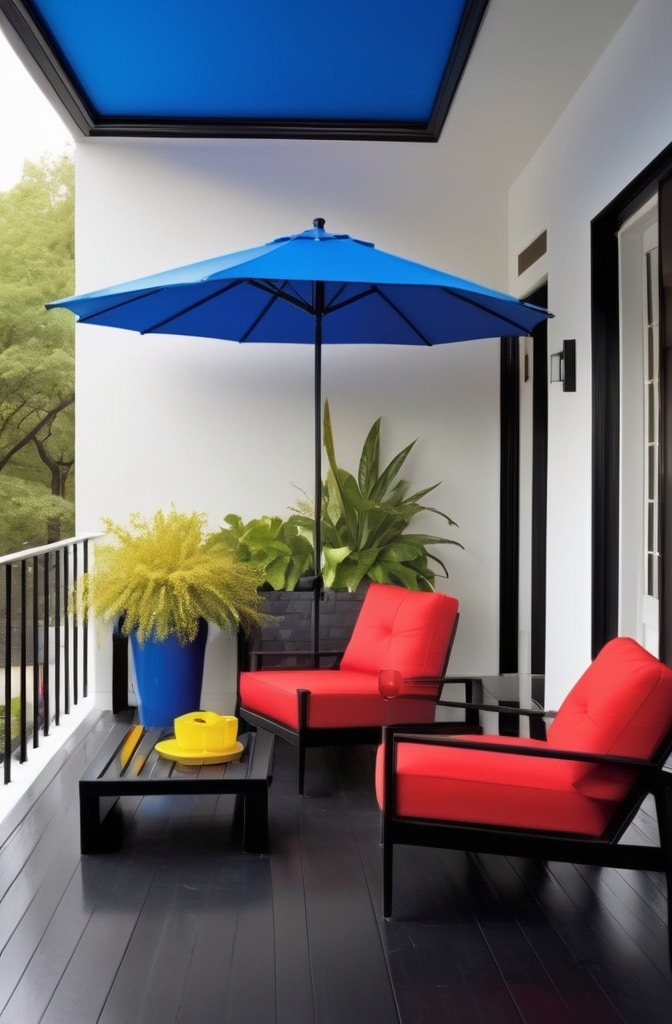
While black works beautifully with neutrals, pairing it with vibrant color creates electrifying energy and contemporary flair. The black background makes colors appear more saturated and intentional.
Particularly effective color pairings include:
- Emerald green – creates a luxurious, biophilic feeling
- Mustard yellow – adds warmth and sunny optimism
- Cobalt blue – offers sophisticated contrast and depth
- Coral – brings warm, living energy to the space
- Violet – creates a sense of creative, artistic energy
“Think of black as the perfect eyeliner—it defines and intensifies whatever it frames,” suggests color theorist Patricia Wong. “The key is choosing colors with enough body to stand up to black’s strength.”
For a cohesive look, repeat your chosen accent color in at least three places throughout the room, varying the scale from large elements like sofas to small accessories.
Design Concept 19: Black Wall as Room Divider
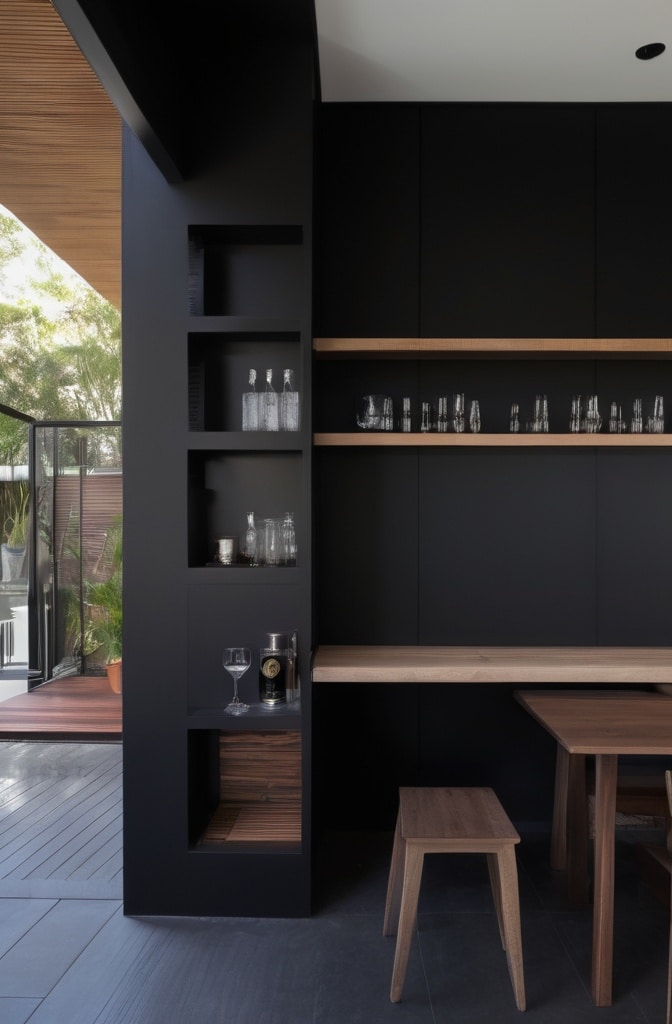
In open-concept living areas, a strategically placed black accent wall can define separate zones without requiring physical barriers that interrupt flow and light.
Effective approaches include:
- Painting a half wall or pony wall in black to define a conversation area
- Using black to highlight a change in ceiling height between spaces
- Creating an L-shaped black treatment where living areas meet dining zones
- Applying black to the wall behind a console table used as a boundary marker
- Extending the black treatment partially onto the ceiling to define an intimate seating area
“Color zoning is increasingly replacing physical dividers in contemporary homes,” notes architectural color consultant Rafael Jimenez. “Black is particularly effective because it creates a strong visual boundary while remaining architecturally minimal.”
This solution works exceptionally well in loft spaces or homes where permanent walls would compromise natural light or ventilation.
Design Concept 20: Future-Forward Black

As technology and sustainability converge, new expressions of black are emerging that offer enhanced functionality and environmental benefits. These next-generation options take black accent walls beyond mere aesthetics.
Innovative options to consider:
- Heat-absorbing black formulations that improve energy efficiency
- Air-purifying black paints that capture indoor pollutants
- Acoustic black panels that reduce sound reflection
- Interactive black surfaces that respond to touch or movement
- Photoluminescent black treatments that absorb daylight and glow subtly at night
“We’re seeing tremendous innovation in functional finishes,” explains sustainable design expert Emma Rodriguez. “Black is no longer just a color choice but a performance decision that contributes to healthier, more efficient living environments.”
While some of these technologies come at a premium price point, they represent the convergence of aesthetics and functionality that defines contemporary design thinking.
Maintenance and Practical Tips
Black walls require some special consideration for long-term success:
Choosing the Right Finish
- Matte – most forgiving of wall imperfections, but least scrubable
- Eggshell – good middle ground between durability and sophistication
- Satin – more washable but shows more imperfections
- Semi-gloss or gloss – highly durable but will highlight every flaw
Keeping Black Walls Fresh
- Dust regularly with a microfiber cloth to prevent buildup
- Keep a small container of touch-up paint handy for quick repairs
- Consider a washable formulation in homes with children or pets
- Use soft brushes rather than abrasive pads for cleaning
- For painted walls, refresh with a new coat every 3-5 years to maintain intensity
“Black shows everything and nothing,” notes professional painter Sandra Martinez. “Dust and fingerprints are more visible, but scuffs and minor damage often blend right in.”
Conclusion
A black accent wall is much more than a design trend—it’s a versatile technique for creating spaces with depth, character, and sophisticated drama. Whether your style is minimalist modern, industrial eclectic, or classically elegant, there’s a way to incorporate this powerful design element to transform your living room.
Remember that successful design is about balance. Your black accent wall should be complemented by thoughtful lighting, appropriate textures, and strategic furniture placement to create a space that feels both bold and welcoming.
Which of these twenty inspiring ideas resonates most with your living space and personal aesthetic? Perhaps it’s time to embrace the dark side of interior design and discover how a black accent wall might transform your home.
